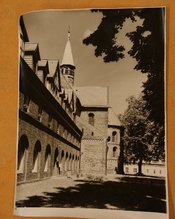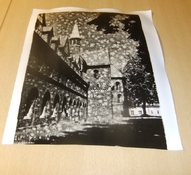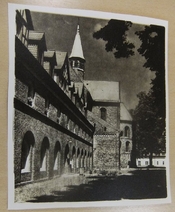Reginald S
Member
Dear folks,
have you ever heard about producing a kind of snowballs while lithprinting ?
I have heard about but never seen until the last day on my Fomabrom Baryta.
I have to state that this roll has been slightly fogged some years ago, and gave me my best second path lith development and best control ever out of this condition.
Thisadays the fog is of higher dense but I gave it a try.
The scene has been summerlike, hot and nearly cloudless sky, recorded at highnoon, here printed on old Fomatone Baryta:

Now the somehow rotten Fomabrom.
Development in the Lith bath became weird soon:
Lights came out first but as a muddy grey mass.
Shadows tried to appear but this seemed to be a hard job.
After a while and having the print seen delicate and nearly printed to the end the snowballs began to rise up to their best appearance:

I have been curious what would happen under other conditions like less/more light, more fat Lith developer - the same.
I didn't found things working better.
I had the idea of printing way darker and then bleaching back the lights with Farmer's reducer.
With increasing darkness the snowballs now changed to marble structures, the bleached print at least came out somehow artistic:

Mr. Moersch described the snowball effect as exclusively seen on Fomatone .
Foma stated an emulsion change fom a certain charge number on.
Mr. Moersch is promising cure by slowing down the developer with adding LithD and increasing exposure (which makes the Lith faster) which all makes sense to me.
I gave it a first try but without success.
Since the developer needs 100 Lith A+B of 900ml water which is not much to mainly 12x16" prints I am not interested in wasting Morsch's good stuff with further experiments.
Because half a roll of Fomabrom remained I will give it another try with developing in Moersch Polychrom with is a twobath of Lith first until the shadows have their dense, followed by a so called Siena developer where the lights develop and where colors could be manipulated by adding different agents like chloride and Kaliumcarbonat.
Reginald
have you ever heard about producing a kind of snowballs while lithprinting ?
I have heard about but never seen until the last day on my Fomabrom Baryta.
I have to state that this roll has been slightly fogged some years ago, and gave me my best second path lith development and best control ever out of this condition.
Thisadays the fog is of higher dense but I gave it a try.
The scene has been summerlike, hot and nearly cloudless sky, recorded at highnoon, here printed on old Fomatone Baryta:

Now the somehow rotten Fomabrom.
Development in the Lith bath became weird soon:
Lights came out first but as a muddy grey mass.
Shadows tried to appear but this seemed to be a hard job.
After a while and having the print seen delicate and nearly printed to the end the snowballs began to rise up to their best appearance:

I have been curious what would happen under other conditions like less/more light, more fat Lith developer - the same.
I didn't found things working better.
I had the idea of printing way darker and then bleaching back the lights with Farmer's reducer.
With increasing darkness the snowballs now changed to marble structures, the bleached print at least came out somehow artistic:

Mr. Moersch described the snowball effect as exclusively seen on Fomatone .
Foma stated an emulsion change fom a certain charge number on.
Mr. Moersch is promising cure by slowing down the developer with adding LithD and increasing exposure (which makes the Lith faster) which all makes sense to me.
I gave it a first try but without success.
Since the developer needs 100 Lith A+B of 900ml water which is not much to mainly 12x16" prints I am not interested in wasting Morsch's good stuff with further experiments.
Because half a roll of Fomabrom remained I will give it another try with developing in Moersch Polychrom with is a twobath of Lith first until the shadows have their dense, followed by a so called Siena developer where the lights develop and where colors could be manipulated by adding different agents like chloride and Kaliumcarbonat.
Reginald
Last edited:





